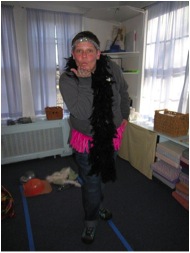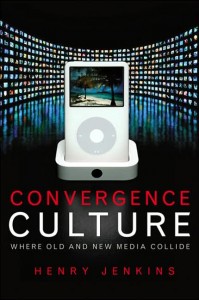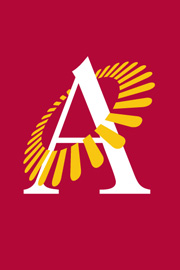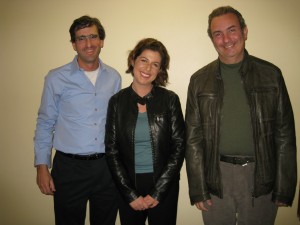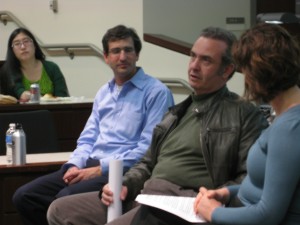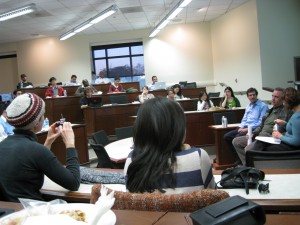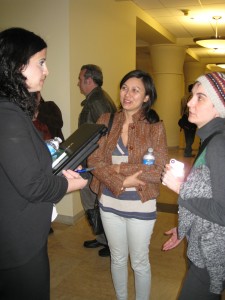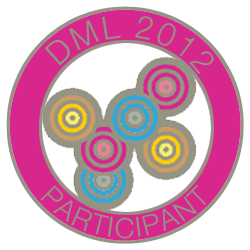 A single conference cannot propel a movement; the work must continue on the ground. To that end, we convened a post-DML reflection session on March 21, 2012, in order for the USC community to: reflect on DML 2012; list out our projects to increase transparency and synergy across the university; support the development of conversations and working groups; and make our vision a reality!
A single conference cannot propel a movement; the work must continue on the ground. To that end, we convened a post-DML reflection session on March 21, 2012, in order for the USC community to: reflect on DML 2012; list out our projects to increase transparency and synergy across the university; support the development of conversations and working groups; and make our vision a reality!
Notes from post-DML reflection session
ATTENDEES
Otto Khera
Susan Harris
Zoe Corwin
Tracy Fullerton
Anthony Maddox
Pat Beckmann-Wells
Gabe Peters-Lazaro
Sean Bouchard
Elizabeth Swensen
Kristy Norindr
Laurel Felt
Brendesha Tynes
Susana Ruiz
INTRODUCTIONS & CURRENT PROJECTS
Otto Khera: two roles @ USC — Center for Scholarly Technology (service group on campus for teaching and learning with technology; particularly interested in embedded assessments as it relates to authentic activities, not traditional assessment measures; working with Susan Harris at JEP on badges and other things that relate to service learning initiatives in supporting her with “low hanging fruit” — here’s some infrastructure instead of Blackboard, Turnitin, for example; looking at badges and seeing an alternative for assessing learning and that is interesting and deserves a look); connection to ASCJ as a graduate student working with Francois Bar, Ben Stokes, George Villanueva & developed a platform called ParTour to design a bike ride to improve people’s mental map that had been crowded by ignorance or other perceptions, can take a picture and upload to a site, add some text, populated via SMS = crowd-sourced storytelling; will be officially announcing on 4/19 a USC Commuters’ bicycle site with Francois Bar & Melissa Loudon, intersects with gameification; Otto’s center puts on great PD/info sessions for faculty — May 1 Teaching with Technology conference called “Where is Learning?”, technologies and strategies can support learning in and outside of the classroom
Susan Harris: students get credit in courses for service projects, playing with ways to use technologies to bring students together in ways, build community; submitted badge application to DML competition (not funded but still looking for ways to move forward)
Zoe Corwin: significant USC presence at DML, sociologist by training who works with Bill Tierney at Rossier; practitioner conferences are more normative; DML feels like it’s where we need to be thinking and doing, at the cutting-edge; in Year 4 of Collegeology with Tracy, Sean, and Elizabeth = awesome card game and FB game that will go online as soon as college approves privacy policy; college access goal; potential of games to engage kids, function as scale-able
Tracy Fullerton: game designer, direct the GIL, working on Collegeology, projects with Todd on Thoreau’s stay at Walden Pond & alternative reality game “Reality Ends Here” that got incoming SCA freshmen to engage with community & number of other projects cooking around here; anti-badge, believes that motivation comes from within, games and badges don’t create motivation; great games take existing desires and channel and give permission for that desire to grow and be fostered in communities in wonderful experiences; badges are technological markers or states that can’t encapsulate that idea or its richness; does believe in some badge people’s aims
Anthony Maddox: science teacher educator at Rossier; introducing these students to participatory learning; believes that must co-create experiences, n ew technology has shifted control to learner, teaching inquiry-based learning; believes that informal learning space will dwarf formal learning space by many orders of magnitude; what is the credential you get out of learning in that space? probably not degree, badge, or something we’ve considered yet, will probably have many flavors; has to lead to employment/something that people must do — can’t divorce ourselves from end outcome; Learning in Informal and Formal Environments at U of Washington; professionally licensed as an engineer
Pat Beckmann-Wells: animator and game designer for years, written a few books on computer animation, creating believable diversity in games with artists at Activision, completed a universal design learning app on narrative skills, working to get that into skills; getting EdD at Rossier; working as art director at rehabilitation games company — do therapy with patients (Sheryl Wells, Blue Marble); partnering with Bone Clones, who research bones around the world (what makes skeletons different based on diet and regional variations) — studying differences in facial anatomy from forensic point of view in order to create believable diversity in games
Gabriel Peters-Lazaro: work in SCA at IML; full-time staffer, part-time iMAP PhD student, presented IML research at DML, looking at mostly early childhood education (4-8 years old), doing digital learning, technological interventions in their learning spaces, how different media production technologies might enhance traditional literacy, computational thinking, open pedagogies, interested in designing interventions in that space, and they tend to be playful and incorporate game-making especially
Sean Bouchard: staff at GIL, working on Collegeology
Elizabeth Swensen: staff at GIL, working on Collegeology; moving on to a game for middle schoolers around college access; also developing a game for students who are trying to understand financial literacy and choosing optimal college path; gave away 1000 card games and are trying to sell 4000 on Amazon; FB game is free; conscious of not making players buy things; students from NAI answered “What did you learn? What would you do differently the next time?” and it was as if they had spit back the game’s learning objectives
Kristy Norindr: research manager at GIL; working with Susana, Tracy, and Laurel through USC Impact Games; project management and event organizing; building new teams for future grant projects, forging new relationships and new projects; DML was back-to-back with Game Designers’ Conference
Laurel Felt: see laurelfelt.org
Brendesha Tynes: at Rossier, working on NIH study to look at online victimization’s impact on teens’ academic performance; wants to design something that will help teens to cope with the victimization they experience and be more critical about the messages they receive online; also working with Anthony on design of a platform to help teachers incorporate technology into their lesson plans
Susana Ruiz: PhD student in iMap with Gabe, alum of MFA with Sean and Elizabeth; games’ intersection with non-fiction documentary and activism; practice-based dissertation, designs games
TAKEAWAYS FROM DML
-keeping people at the center, technology as a bridge, better-than-nothing, not substitute for the
-Nokia Research Labs, Tico Ballagas, did an experiment with Where the Wild Things. In his version, Max + child + parent who were reading went on voyage in the book; webcam cuts out their image and inserts them in the boat, in the bushes, etc; weren’t in the same place but felt like they were — this little project had so much heart — both exclaimed when their images tipped toward each other because they felt like they were closer together, that’s when technology sings; technology is a can opener, what we remember is the experience
-refreshing absence of discussion of devices, platforms, technologies; for someone who goes to EduCause and everyone’s pretending it’s about learning; hearing different voices, seeing the people, including the K-12 where there’s so much energy
-at one panel, students had participated in critical research project through UCLA with emphasis on technology, 5 student groups presented what they had learned and how they had empowered by doing their research on technology; really moved by those sessions; social justice message; illustrating how they’re shut down in their classes when they use cell phones to take notes; don’t have high speed internet access; equity issues
-put feelers out to UCLA, UC-Irvine?; Kristy “I have become a bridge”
-how to reconcile exciting work that’s being done in extra-curricular with feeling of inability to penetrate school day; people have given up = interesting issue
-ways of bridging and integrating parent involvement more, not very many presentations addressing that
-Katie Salens’s keynote at Education Summit at GDC, inspiring to see how far they’ve come in their curriculum; kids have vocabulary about system design that parents don’t have, starting to involve parents in their projects so they can have a common language to discuss homework with kids; their vocabulary tries to couch things with that sense of allure, e.g., Science is called How Things Work
-does it take a wholesale, unified entity to make this type of change?
WHAT HAPPENS NEXT?
-compiling a list of all of the presentations, all the people there, JSB was opening keynote, sending this to President Nikias, tell him that we had a strong presence — list of attendees, list of attendees, here are three questions that we are moving forward with
-participation gap, what we do and do not know, what are kids around USC doing with technology?
-can we synergize in terms of methodology, digital ethnography, pool what we know about urban kids in LA
-Nikias is interested in impact, is learning happening, interdisciplinary work; calling attention to the fact that our different disciplines share interests and goals, important moment to acknowledge our work and relationship building
-can we create a global, one-room schoolhouse where teacher is coach, different age groups work together and older ones teach the younger ones — how can we recreate the one-room schoolhouse with the technology we have or build?
-participatory communities, affinity spaces where learning occurs, capture that and channel that towards something that takes itself even further
-games work ushers in a new area for education; have looked at qualitative, quantitative, and now this is computational; this is a good place to start, we can import from physical world; games = interactive, humanistic
-send letter to our deans
-capitalize on funding announcements for interdisciplinary research
-an actual event could probably get funded — like a one-day conference
Post-session progress
1. Gabe Peters-Lazaro is drafting a letter for USC administrators about who we are and what we intend to do.
2. Otto Khera is working on a Popplet visualization of USC folks’ research interests and projects.
3. I have compiled a list of USC’s attendees of DML 2012.
4. We would love if a kind-hearted soul with extra time or an appetite for evasion would do us the following favor: Please go through the DML program and copy and paste the overview of each presentation made by a USC person into a GoogleDoc. Let me know if you can take this on!
5. Finally, here are two DML-related reports from the FrameWorks Institute that may be of some interest.
In “The Stories We are Telling: How DML is Communicated by Ed Reformers,” the FrameWorks Institute mapped out the influential organizations in the ed reform field and analyzed if and where these orgs put DML on the larger ed reform agenda. “Valuing DML” presents the results of a values survey that assess which values work best for gaining support for DML from the public.
21stcenturyscholar.org
Thanks to Zoe Corwin‘s invitation, Elizabeth Swensen, Antero Garcia, Otto Khera and I wrote blog posts about DML that will be shared on 21stcenturyscholar.org from April 10-April 13.
Here is my post, “Digital Devotees are Made of People!: Leveraging Our Humanity to Enrich Digital Media and Learning.” In this piece, I argue for the importance of remaining people-centered.
I truly appreciate the opportunity to share my thoughts with a wider audience and hope this helps, in some small way, to keep the community (and, importantly, those outside the community) informed and engaged!


